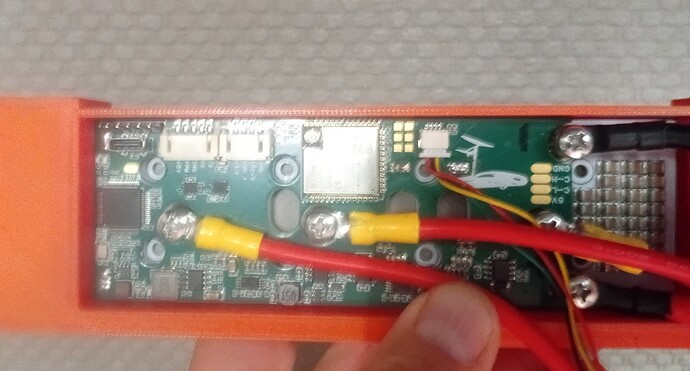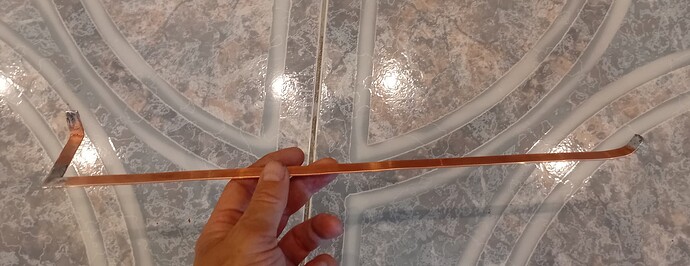@rttn What silicone did you use for you battery?
The most common electrical silicon, similar to this one. Electrical Waterproof Gel | Junction Box Gel | IP68 Insulation Seal My requirements are: it should be clear, curing within an hour.
Work on installing the new controller is progressing quite slowly. At this stage I have a problem with Bluetooth. VESC Tool sees the adapter, but does not connect to it. I would bring USB to the back wall instead of Bluetooth, but it does not fit into the dimensions. Their positive moments - the turner finished milling the radiator and I liked how he did the finishing.
Why did I even decide to install this controller? This year I took part in the e-foil race for the first time. And of course, I didn’t win, because the e-foils were provided by the organizers and I essentially stood on it for the first time before the race. Previously, I constantly took part in competitions, albeit of a different kind, but the familiar feeling of excitement returned to me. Therefore, I want to build a light e-foil based on a foildrive in the 14 or 16s 2P configuration, weighing no more than 15 kilograms, in order to win the race next year)
I’ve been asked a couple of times in private messages if I use copper busbars when making batteries. Of course I do. Here it is.
I think you might need to first connect by usb and get the UUID and save it in vesc tool somewhere.
Thank you, I’ll try…
This looks like one of EasyFoil’s new vescs? I’m curious to see how it works out for you. I have been considering it, a decent price and hopefully well designed by some sensible Germans for foil applications. Are you putting this into a foil assist?
That’s right. I just had to change the box a little. I hope this controller works as well as it looks.

Yesterday I rode a 27-liter Armstong. I’m still far from heiguga records. On the other hand, I weigh almost 10 kilograms more. Next time I’ll try a 16-liter Slingshot Dwarf, but I doubt it will work. A couple of days ago I completely flooded the case with water. Apparently, something got between the seals. However, the electronics survived. I drained the water, dried the battery, washed the controllers with isopropyl alcohol and the next time I rode without problems. Treating the controllers with varnish saved me from another repair.
Tried a 16 liter Slingshot today. It worked twice, unfortunately only on my knees. I cut my new wetsuit a couple of times on the stabilizer winglets. I concluded that it is definitely possible, but I don’t have a large supply of wetsuits, so I’ll stop experimenting for now )
If I start my low volume board on the tow boogie, I start like a wakeboard waterstart. The feet already on the board, but instead of having the board in 90 degree, keep it inline with the tow direction. When going try to get the tip out of the water. As soon as the tip gets out, speed increased an you are out of the water, already on your feet’s…
I will do a short video next time.
Maybe I misunderstood, so I deleted my post. I tried to take off in different ways - lying down and sitting on the board. And I only managed to take off lying down. When I’m sitting, there is not enough power to raise the nose, and the controllers eventually turn off. When I’m lying on the board, takeoff is possible, but there is no time to get up. Although I understand that it is possible, and it’s just a matter of training. I will watch your video with interest.
I do this, lying and accelerating until board has lift from the foil, and then a popup at low planing speed. It takes a bit of practice to make the popup at that speed as the foil will have started to lift, but once you get it it is quite easy
I
I find this way very hard with very low volume boards. Although I am trying to do it too because it needs less battery power compared to the launch described above.
I would like to clarify what volume of boards you are talking about and what is your own weight.
32L for 70kg, I have lots of prone foil experience which helps with the surf style popup, for me the hardest part is steady throttle while transitioning
Same for me, prone experienced, 88kg, 4’4 31lts board, take off possible even with 8 knots in front with a 1100cm2. With more windchop, my dual motor tow starts to cut at 140 amp.
My technique (the less current demanding for sure ):
Remote on left hand
Handle on right hand
Lay down with 2 forearms on the front of the board until reach speed for foil activation
Surf take off on forearms kept flat on the deck.
Be careful not to puncture the deck with elbows !
Planing and transitioning is easy for me on my 40 liter prone board. But it is a different level on my 14liter board. Planing on very low volume is like as soon as it touches the water you nose dive. Although it is possible and I try learn it. But starting low volume as described above is way easier for me (and also saves your wetsuit).
Ok I can see how that is entirely different, I can’t really imagine a huge benefit for what must be a huge drain on your batteries. Once 12S goes down below 3.5v I find even on the 30L it’s much more technical




